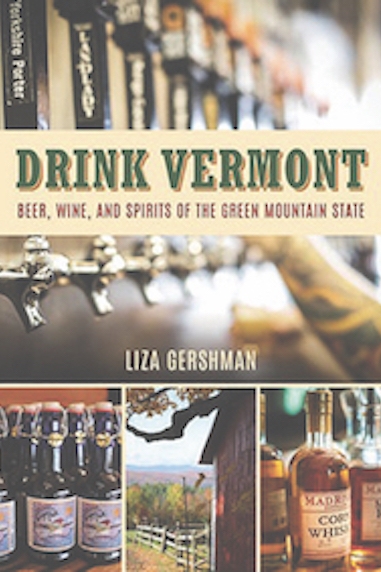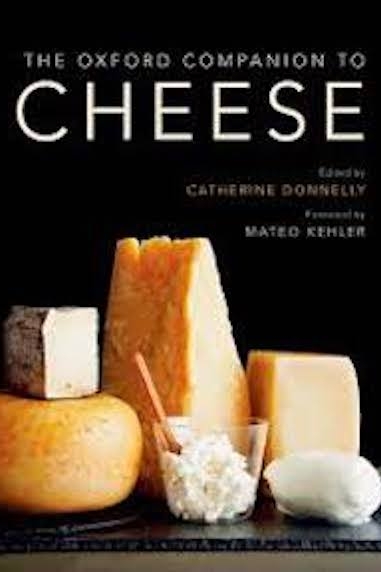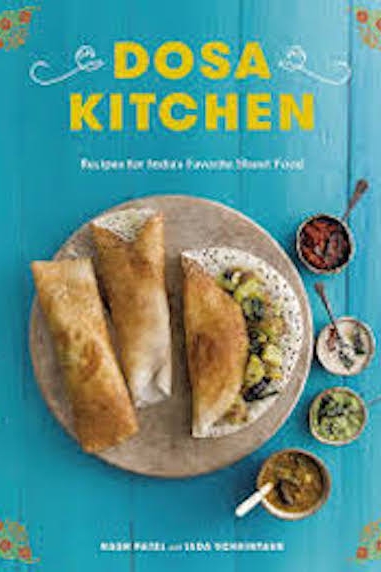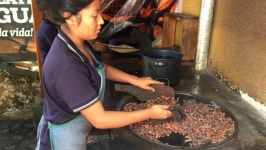Holiday Reading
Cheese. Booze. Indian street food. Supermarkets. This year’s top reads cover the spectrum. Michael Ruhlman dives deep into the American grocery store to ascertain how that experience both shapes and reflects our culture. Catherine Donnelly, professor of nutrition and food science at the University of Vermont, has compiled The Oxford Companion to Cheese. In 2017, Donnelly won the prestigious James Beard Award for Reference, History and Scholarship for this encyclopedia of all things cheese. Liza Gershman immersed herself in Vermont’s booze scene and her new book, Drink Vermont!, shares the backstories of the nearly 100 breweries, distilleries, wineries and cideries that make this state a magnet for the thirsty. And Nash Patel and Leda Scheintaub, co-owners of Dosa Kitchen, Vermont’s only South Indian food truck, have produced a cookbook with 55 recipes for dosas, crepe-like wraps that can be stuffed with both savory and sweet fillings. These books are just the ticket to keep you inspired and pull you through the cold months ahead!
Grocery: The Buying and Selling of Food in America
By Michael Ruhlman
Published by Abrams Press
A family’s largest expense, after housing and transportation, is food. We spend approximately 10% of our income to feed ourselves. And unless you’re a dedicated patron of farmers’ markets and co-ops, how much do you actually know about your local grocery store, a place most Americans visit on average twice a week? Michael Ruhlman believes that grocery stores are a reflection of our culture and serve as a lens through which to examine many of the critical food and health issues we face today.
There are 38,000 grocery stores in America, each driven to provide everything we could possibly want, or be convinced we need to purchase. (Have you sweated over which flavor Triscuits to buy? How about dried pasta, orange juice or even something as quotidian as eggs?) The modern supermarket stocks the shelves with approximately 45,000 individual items, each with a unique bar code. Whole Foods offers about half that while places like Costco, Sam’s Club and BJ’s typically carry about 4,000 grocery items.
Ruhlman points out that American food shopping changed in 1988 when Walmart branched into groceries and quickly became the biggest grocer in the world. “The opening of the first Walmart Supercenter signaled the beginning of the fragmentation of the food retail world,” Ruhlman writes. That same year, Whole Foods expanded beyond Texas and quickly evolved into a thriving chain. At differing ends of the spectrum, these two behemoths effectively—and permanently— altered the entire industry, from how food is grown, marketed and consumed.
In this latest book (his 20th!), Ruhlman focuses on Heinen’s, a family-run grocery business based in Cleveland. With 22 stores, Heinen’s sheds light on how a traditional supermarket strives to remain relevant amidst the trend of online ordering and home delivery services.
The book is an engaging must-read for anyone who loves thinking about or shopping for food. Ruhlman provides just enough historical background on the evolution of grocery stores without getting dry. The short chapters are peppered with wellresearched facts and anecdotes, and this page-turner takes you on a romp across America with Ruhlman as a knowledgeable and engaging guide. Ruhlman has mastered the deep dive into a broad topic, deftly alternating between 30,000-foot views and microcosmic focus. As a bonus, he offers a suggested reading list of 32 books that explore other aspects of the food industry, written by luminaries such as Michael Pollan, Marion Nestle, Barry Estabrook and Ted Genoways.
As Ruhlman observes, “Thinking should be our first step in shopping.” Take that first step with this book in hand.
Drink Vermont: Beer, Wine, and Spirits of the Green Mountain State
By Liza Gershman
Published by Skyhorse Publishing
50 breweries, 21 wineries, 16 distilleries and 6 cideries. Liza Gershman has compiled a love song to Vermont, an ode to the magical elixirs produced in this state. Replete with interviews, anecdotes and backstories of the makers, this well-organized mini encyclopedia provides concise overviews of each business. You’ll find yourself skipping around in search of your favorite producers while taking note of newer establishments and products to seek out. Whether you’re lucky enough to live (and drink!) here or just want to learn more about the burgeoning realm of Vermont-crafted drinks, this book is a perfect resource and a fun read.
The second half of the book contains recipes for 40 unique cocktails created by two mixologists to highlight the range of products, and most include classic Vermont flavors. Try the Bramblin Man made with Barr Hill Gin, rhubarb syrup and Boyden Farm Cassis, or the Vermont Smash with Appalachian Snowfall Whiskey, maple syrup and mint. And who could pass up the Late Breakfast, composed of Mad River Rye, Appalachian Kaffevan coffee liqueur, Saxton’s Sapling maple liqueur and orange bitters?
Each section starts with an introduction written by a leader in that fi eld, such as Sean Lawson for brewing, Mimi Buttenheim of Mad River Distillers, Sara and Chris Granstrom of Lincoln Peak Vineyard, and Colin Davis of Shacksbury Cider. Gershman adds a Vermont Resources section in the back that offers information on brew tours and driver services.
The Oxford Companion to Cheese
By Catherine Donnelly
Published by Oxford University Press
Milk, microorganisms, salt and enzymes. For centuries, these four elements have been transformed into more than 1,400 cheese varieties around the world. And as Mateo Kehler of Jasper Hill Farm in northern Vermont observes in his foreword, “Every cheese embodies the particulars of history and the place and people that produced it in a way that few other products can match.” In the late 20th century, the United States helped spur the renaissance of artisan cheese, and our nation now boasts the fastest-growing market in the world for specialty cheese.
Winner of the 2017 James Beard Award for Reference, History and Scholarship, Dr. Catherine Donnelly, professor of nutrition and food science at the University of Vermont, has edited this major reference work that sheds light on every conceivable aspect of cheese. She compiled more than 850 entries written by 325 professionals in their fi eld, ranging from cheese makers, cheese mongers, scientists, journalists, anthropologists, and beyond, representing 35 countries. The Oxford Companion to Cheese is a true global collaboration on the history, science and culture of cheese.
Ever wonder about what distinguishes Camembert from Brie, or what a curd knife is, or the difference between lactobacillus and Lactococcus lacris? This book has all the answers. You can learn how Robert Hooke’s newly invented microscope in the mid-1600s helped him provide detailed descriptions of blue and white cheese molds, and that Homer’s Odysseus discovered wheels of cheese ripening in the Cyclops’ cave. And lest you think this is purely a scholarly work, Cheez Whiz and Monty Python get their own shout-outs.
The encyclopedia covers specific cheeses, the process and technology of cheese making, internationally acclaimed shops and renowned producers around the world. Contributing authors include Anne Saxelby, Paul Kindstedt, Edward Behr, Max McCalman, Ricki Carroll, Kate Arding, Peter Dixon, Molly Stevens, Clark Wolfand Bronwyn Dunne. This 850-page hardcover tome, the quintessential resource for turophiles, deserves a prominent place on a kitchen counter or culinary bookshelf where it can see frequent use and live up to its worthy title.
If you live near or pass through Brattleboro, you may have savored the creative South Indian soul food at Dosa Kitchen. This cheerful skyblue food truck is parked at the Retreat Farm adjacent to Grafton Village Cheese, just north of town on Route 30. Co-owners Nash Patel and Leda Scheintaub serve up traditional homemade Indian dosas: crisp, airy, slightly tangy crepes made from a batter of fermented rice and dal (chickpea and lentil). This iconic street food is the ideal base for both spicy and sweet fillings and holds up well with chutneys and dipping sauces.
The couple now has compiled a cookbook so readers can prepare the dosas at home. All 55 of the recipes are gluten-free, and because they’re fermented, dosas are easier to digest than a bowl of rice or lentils. Dosas are a blank canvas waiting to be painted with just about anything, and the authors generously offer a delectable array of fillings, from vegan (nutty falafel with turmeric tahini sauce; spicy ratatouille; Indian-spiced mashed potato) to decidedly not (ginger chile beef “fry”; smoky chicken curry; pulled pork with tamarind barbecue chutney), egg and dairy (deconstructed sag paneer; kimchi, bacon and egg; cream cheese, lox and caper) and sweet (caramelized banana and bourbon, cardamom chocolate). They also include chutneys such as coconut, peanut or tomatillo and refreshing drinks like Strawberry Rose Lassi, Sweet and Salty Limeade, and First Date Chai, based on the classic drink Patel made for Scheintaub early in their courting.
The cookbook instructs on how to make the master crepe batter, which may appear daunting at first glance, but don’t panic! It’s worth the bit of effort, and the generous batch of slightly thick, snowy white batter can yield pancake-style dosas and wraps or those crisp, lacy crepes. And if you don’t feel up to the challenge, Patel recommends buying the high-quality dosa batter available in the refrigerator section of most Indian grocery shops.
Patel and Scheintaub are committed to using local and seasonal ingredients in their cooking, and they also share tips on how to stock your pantry and fridge with South Indian staples—spices, seasonings, sweeteners and ghee. So if you’re a fan of South Indian cooking or want to try your hand, this is the ideal place to start!
Dosa Kitchen | @dosakitchen
The Buying and Selling of Food in America
Michael Ruhlman | @michaelruhlman
Dosa Kitchen: Recipes for India’s Favorite Street Food
Leda Scheintaub | @ledaskitchen
Kristin Teig | @kteig
Retreat Farm | @retreatfarm
Grafton Village Cheese | @graftoncheese
The Oxford Companion to Cheese
Catherine Donnelly
Mateo Kehler | @mateokehler
Jasper Hill Farm | @jasperhillfarm
Anne Saxelby | @cheesemonger325
Paul Kindstedt
Edward Behr
Max McCalman | @maitrefromager
Ricki Carroll
Kate Arding | @talbottandarding
Peter Dixon
Molly Stevens | @mstevenscooks
Clark Wolf | @clarkwolf
Bronwyn Dunne | @inthekitchenwithbronwyn
Caledonia Spirits Distillery | @caledoniaspiritsdistillery
Boyden Valley Winery & Spirits
Appalachian Gap Distillery
Mad River Distillers | @madriverdistillers
Saxton River Distillery
Lincoln Peak Vineyard | @lincolnpeak
Shacksbury Cider | @shacksbury












